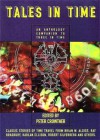Currently reading
The Steampunk Trilogy

by Paul Di Filippo
This book is comprised of three stories reportedly in the popular Steampunk genre, all written by Paul Di Filippo.
They are decidedly mock-Victorian alternative history, lack any of the attendant steam technology which is the defining factor of Steampunk.
I found the first story, Victoria, immediately atmospheric, though some descriptions seemed overly complicated and a few sentences near the beginning were overly long. I soon got involved in the story and established that it is about Queen Victoria and an entity called a 'Hellbender' that might explain some of the conspiracy theorists' speculations that the Royal Family are actually lizard people.
The book displayed a more extensive vocabulary than many modern books exhibit and a rather fantastical plot wherein the Alchemically transformed newt-creature (ala Dr Moreau) impersonates the queen.
There are cameo appearances by such entities as Dickens, Tennyson, Lord Byron and John Ruskin as well as a Parody American character called Nails McGroaty, though the story is mostly from the point of view of Mr. Cosmo Cowperthwait, a tongue-in-cheek version of a Victorian English gentleman who experiments with a method of Uranium based transportation, with predictably disastrous results.
The story is rather whimsical, yet most of the research rings true, keeping in mind that liberties have to be taken in Alternative Histories. There is only a time or two when an American term sneaks in to give away the author's nationality. The prolific use of guns also reflects a particularly American attitude.
There was a surprising twist near the end of this story and it did hold interest, if not believability. It was actually rather fun.
I didn't quite know what to make of the second story, Hottentots. It is about a rather extremely racist scientist who compares mixed-race breeding with cross-species taxidermy and finds himself dealing with a back woman who has been a side show for nothing more than looking different from the average Caucasian. He refers to "Negroes" and I wasn't sure if the author might be racist or whether he was incredibly brave in creating such an offensive character.
He is accompanied by this woman and her husband, an associate of his that has a dodgy mock-Germanic accent as they go on a voyage to find a Fetiche which is supposed to relate to some form of black magic. As Rosicrucians and Satanists were mentioned in the same sentence, followed by a reference to 'Hand of Glory' (from Santeria) and then "Hermetic herbs", bringing Alchemy into the equation, I have to conclude that research about magic for the story was non-existant.
There were cameo appearances by Herman Melville and Darwin, but none of the characters were likable, except perhaps the black woman who seemed to have an amused attitude about it all.
The third story, Emily and Walt, involved a relationship between the two poets, Emily Dickenson and Walt Whitman. I'm not overly knowledgeable about the lives of poets, so I don't know if such a liaison could or might have ever taken place. This one also involved not one but two abortions from the hapless Emily Dickenson and a spiritualist quest to seek communication with her unborn children. It was all a bit surreal.
The writing itself is very good, but I found the second and third stories a little disjointed, too obsessed with genitalia, and generally less interesting than the first story, which I quite enjoyed despite the fact that there was not an airship in sight or any form of alternative steam technology that would have justified labeling the book as Steampunk.





